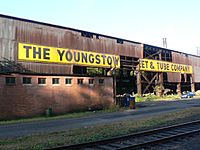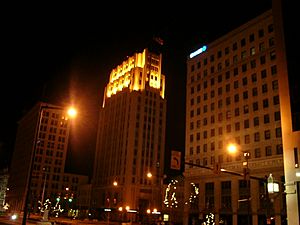Economy of Youngstown, Ohio facts for kids
Youngstown, Ohio, was once a very busy city, especially in the late 1800s and early 1900s. It was famous for making steel, and lots of people moved there to find work. The city grew a lot, and its population reached its highest point in 1930. Even during World War II, there was a huge need for steel, which kept Youngstown's factories busy. However, after the war, the demand for steel dropped. This started a tough time for Youngstown's economy.
Youngstown's economy was hit hard when many steel jobs disappeared. This started on September 19, 1977, a day people in Youngstown call "Black Monday." The job losses continued into the mid-1980s. This was part of a bigger problem across the "Rust Belt" in the United States, where many industrial cities lost their factories. In the Mahoning Valley, where Youngstown is located, the population dropped by half. Many other businesses also had to close or move because of the steel industry's decline.
Contents
Youngstown's Steel Boom
Youngstown was founded in 1797. For its first 50 years, it was a small farming village. But then, the "Second Industrial Revolution" began. People discovered iron ore near the Mahoning River. This made Youngstown a great place to build steel factories. The city is located between other big steel-making cities like Cleveland and Pittsburgh. Companies like Youngstown Sheet and Tube and Republic Steel were major local steel producers. U.S. Steel also had large factories there.
The Youngstown area had lots of coal and iron. It also had large forests for making charcoal, which was needed for early iron production. This helped the steel industry grow. The first furnace was built in 1803. Over time, more coal-powered mills opened. By the mid-1800s, Youngstown had several iron factories. Even when local resources ran low in the 1890s, many train lines brought coal and iron from other states.
Around 1900, local factories started making steel instead of just iron. Many smaller companies joined together to form bigger ones. In 1901, U.S. Steel took over Youngstown's main steel producer, the National Steel Company. But local business leaders, like George D. Wick and James Anson Campbell, wanted to keep ownership local. So, they started the Youngstown Sheet and Tube Company in 1900. This company became one of the most important steel producers in the country.
In the late 1930s, Youngstown's steel industry was in the news again because of the "Little Steel Strike." This was when the Steel Workers Organizing Committee (which later became United Steelworkers) tried to get contracts with smaller steel companies. These included Republic Steel and Youngstown Sheet and Tube. On June 21, 1937, there was violence during the strike in Youngstown, leading to two deaths. Despite the difficulties, this strike was a big moment for workers' rights in the U.S. It helped turn local worker groups into strong, nationwide unions.
In 1969, Youngstown Sheet and Tube joined with a company called Lykes Corporation. Later, in 1979, a large company called LTV bought them both. For the first time, major decisions about Youngstown's economy were made far away. LTV found that many mills in the area were old and needed expensive upgrades to meet new pollution rules. Also, many steel companies were starting to make steel in other countries where it was cheaper and had fewer rules.
Black Monday

From the 1920s to the 1960s, Youngstown was a major industrial center with huge steel factories. However, unlike bigger cities, Youngstown's economy relied almost entirely on steel. It didn't have many other types of businesses. So, when factories started closing in the 1970s, the city had few other options.
The merger of Youngstown Sheet and Tube with Lykes Corporation in 1969 was a turning point. This deal left Youngstown's main steel company with a lot of debt. Also, decisions were no longer made by local people. On September 19, 1977, Youngstown Sheet and Tube announced it would close a large part of its operations. This day is known as "Black Monday." The company immediately laid off 5,000 workers. At that time, companies didn't have to give much notice for mass layoffs.
The closure of Youngstown Sheet and Tube had a huge impact. In 1979–1980, U.S. Steel also left the Youngstown area. Republic Steel went bankrupt in the mid-1980s. People tried to bring the steel industry back, but it didn't work. After the closures, Youngstown lost about 40,000 factory jobs. About 400 smaller businesses that depended on the steel industry also closed. The city lost a lot of income and school tax money. Youngstown is still recovering from these job losses.
The changes also affected non-industrial businesses. The fast-food chain Arby's moved its main office out of Youngstown. Idora Park, a local amusement park, closed in 1984 after several fires. Department stores like Strouss also closed or were taken over by bigger companies. The city tried to attract new steel makers or even reopen Youngstown Sheet and Tube as a community-owned mill, but these efforts failed.
After Black Monday
The loss of factory jobs had a lasting effect on Youngstown. The city's population was cut in half. Many non-industrial businesses also closed or moved. While some other "Rust Belt" cities like Pittsburgh have found new ways to grow their economies, Youngstown has struggled to recover.
New Businesses and Growth
Even during the steel era, some Youngstown-based companies became well-known. For example, Schwebel's Bakery, started in a nearby town, now sells bread across the country. In the 1920s, Youngstown was where the Good Humor ice cream brand began. Handel's Homemade Ice Cream & Yogurt, a popular ice cream shop, started there in the 1940s. In the 1950s, one of the first modern shopping malls was built in a Youngstown suburb. The fast-food chain Arby's opened its first restaurant in Boardman in 1964.
For a long time, the General Motors' Lordstown Assembly plant was a major employer. It was one of the largest car factories in the country. It made cars like the Chevrolet Impala and Cruze. However, GM closed the Lordstown plant on March 6, 2019. Today, Youngstown State University is the largest employer in the area, which is very different from the city's industrial past. Even with challenges, Entrepreneur magazine named Youngstown one of the top 10 cities to start a business in 2009.
Downtown Youngstown has seen some new construction. New government buildings and courthouses have been built. The Youngstown business incubator is located downtown. This group helps new technology companies grow by giving them office space and support. Some companies helped by the incubator have become very successful. For example, Turning Technologies was once named one of the fastest-growing software companies in the U.S. The city has also worked to reopen Federal Street, a main road downtown, and fix up old buildings.
In 2010, a company called Vallourec & Mannesman started building a large pipe mill north of Youngstown. This $620 million factory opened in 2012 and makes steel pipes for natural gas drilling. It has created jobs for 350 people.
Current Steel Operations
Youngstown still has some steel and metalworking businesses, but they are much smaller than during the "glory days" of the "Steel Valley." The largest industrial employers within the city limits are Vallourec Star Steel Company and Exal Corporation.
Past Retail and Fun Spots
Many of Youngstown's fun places closed down after the economic problems began in the late 1970s. One example is Idora Park, an amusement park. It was a popular spot for local families. The park closed in 1984. It's even said that the Warner brothers started their movie business by showing films at Idora Park.
From the early 1900s to the mid-1970s, downtown Youngstown was the main shopping area. It had two large department stores and many specialty shops. There were also four fancy movie theaters. But in the 1970s, two large shopping malls opened in the suburbs. This caused many downtown businesses to close or move. The collapse of the steel industry made things even worse for downtown shops. Efforts to bring back the downtown shopping area in the 1980s and 1990s were not successful.
The "Youngstown 2010" Project
In the 2000s, people in Youngstown decided they needed to change the city's future. They created a plan called "Youngstown 2010." This plan is also called "The Greening of Youngstown" because it involves tearing down many old, rundown buildings and creating more green spaces and parks.
The "Youngstown 2010" plan recognized that the city is now much smaller than it used to be. The steel industry's collapse led to huge job losses and a big drop in population. The city had too many empty buildings and unused areas. The plan aimed to make Youngstown a smaller, more sustainable city.
Key ideas of the Youngstown 2010 plan include:
- Accepting a smaller city: Youngstown lost more than half its population. The plan accepts this new reality and aims to manage the city's size better.
- Finding a new role in the economy: Steel no longer drives Youngstown's economy. The plan focuses on supporting new types of businesses. It looks at strengths like the university, healthcare, and arts.
- Improving the city's image: The plan aims to make Youngstown a better place to live and work. This means fixing up rundown areas and improving neighborhoods, the downtown, and schools.
- Calling people to action: The plan encourages local leaders and residents to get involved and help make changes. It focuses on practical steps and celebrating successes.
By accepting its smaller size and focusing on green spaces and new businesses, Youngstown has gained attention for how it's dealing with the challenges of losing its main industry.
Images for kids
-
An abandoned facility of the Youngstown Sheet and Tube Company, owner of the Jeanette Blast Furnace. The Furnace is called "Jenny" in the 1995 Bruce Springsteen song "Youngstown", which is about the decline of Youngstown as an industrial city.







